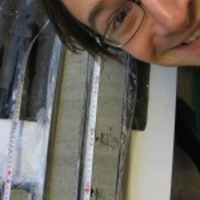
Frédéric Rossano
Frédéric Rossano is landscape architect and associate professor at Strasbourg School of Architecture.
He graduated from Versailles School of landscape architecture, and holds a Doctoral degree from ETH Zurich.
His teaching and research focus on design approaches of landscapes and inhabited environments, and more specifically on the integration of water dynamics and natural risks within urban and regional planning.
From 2000 to 2012, he led numerous planning studies and urban projects in France and Switzerland as project Coordinator and Associé France for KCAP Architects and Planners Rotterdam/Zürich.
His teaching and research experience was gained through directing design workshop, semester studios and master theses in various international academies and universities (Versailles, Lille, TU Delft, Amsterdam Academie van Bouwkunst), as a landscape design teacher at ETH Zürich from 2008 to 2015, and as associate professor at Strasbourg School of Architecture since 2016.
Address: Strasbourg, France
He graduated from Versailles School of landscape architecture, and holds a Doctoral degree from ETH Zurich.
His teaching and research focus on design approaches of landscapes and inhabited environments, and more specifically on the integration of water dynamics and natural risks within urban and regional planning.
From 2000 to 2012, he led numerous planning studies and urban projects in France and Switzerland as project Coordinator and Associé France for KCAP Architects and Planners Rotterdam/Zürich.
His teaching and research experience was gained through directing design workshop, semester studios and master theses in various international academies and universities (Versailles, Lille, TU Delft, Amsterdam Academie van Bouwkunst), as a landscape design teacher at ETH Zürich from 2008 to 2015, and as associate professor at Strasbourg School of Architecture since 2016.
Address: Strasbourg, France
less
Related Authors
Kim M Cohen
Utrecht University
David Seamon
Kansas State University
Jeffrey Hou
National University of Singapore
Peter D Clift
University College London
Lucien F Steil
University of Notre Dame
Enrique La Marca
Universidad de Los Andes (Venezuela)
Timothy Morton
Rice University
Derek H Alderman
University of Tennessee Knoxville
Ian G Baird
University of Wisconsin-Madison
Raffaele Pernice
UNSW
InterestsView All (8)










Uploads
Papers by Frédéric Rossano
For Strasbourg and the Upper Rhine Region, water has always been a fundamental element for urban and territorial development. This article illustrates a critical understanding of the historically and culturally-based processes that shaped and transformed this territory over time through water management and different urban rationalizations. Each historical phase, conditioned by different ideologies, social needs and desires, revisits and relates differently to the geographical, topographical and hydrographical features of the territorial support, producing different landscapes and spatial organizations.
The text then focuses on the current period still under construction, pointing out the conflicting lines and spaces of negotiation for reinventing Strasbourg’s relationship to water, while articulating the cross-border metropolitan ambition, a reconsidered value of the “blue thread” through new urban development, public uses and ecological concerns, the water uses and structures inherited from the previous periods, and the risks related to recent drought events that are likely to become more frequent.
The article finally presents briefly our active contribution in this sense as researchers and urban designers. Reaching for a renewed complex, multi-scalar and multi-actor approach, we defend a conceptual framework relying on design as a negotiation platform where water, as a structuring network, a territorial matrix and a fluctuating resource, could re-engage all design scales: watershed, metropolis, city, district, public spaces, buildings.
download link :
https://www.institutparisregion.fr/nos-travaux/publications/integration-du-risque-inondation-un-programme-national-aux-pays-bas.html
In recent decades the gardens of Gilles Clément or Piet Oudolf brought at high costs the poetry of formal vagueness and apparent vegetal spontaneity into the wastelands of nineteenth century New York railways and Paris factories – two cities seen as ultimate temples of urbanity. With them, the urban garden has seen the return of grasses and annual flowers, occasionally rehabilitating indigenous, even toxic or invasive plants. More recently, with the transformation of the Isar River in Munich, the return of the wild has gone a step further in scale and meaning: About eight kilometers of channeled waters have been partially “set free” by a design that celebrates natural fluctuations and indigenous riparian vegetation in the heart of Bavaria’s capital city. Each year after the spring floods, meadows and muddy river flats punctuated by young willows are again open to a growing public of urban hikers, picnickers, party-goers and beach lovers, becoming a much loved urban space and an iconic manifestation of the city’s quality of life and individual freedom.
For the recent design of the central segment of the river, however, a fierce quarrel has opposed the supporters of a sharp landscape design that accepted the urban and artificial character of the river, to the outspoken proponents of a nature-like design. New expectations and illusions had arisen with the dreams of regained wilderness that challenged the consensual tradition of the city, the adaptability of its urban infrastructure, and the ethics of the designers commissioned to reconcile the inherent contradictions of the brief. With its nature-like island and meandering banks stabilized by invisible stones and concrete foundations, has the Isar become merely a pastiche, being to riparian nature what Queen Marie-Antoinette’s Hamlet was to actual countryside? The discussion is still ongoing, but beyond the controversy, the Isar Plan has so far succeeded in accommodating seasonal flooding, individual contemplation and mass-recreation, creating a flexible and unprogrammed space that is not a park, not a flood zone and not a nature reserve, and yet all these together. In this regard the Isar Plan might be the forerunner of a genuine trend that sees cities reinventing a form of wilderness that can answer the need to accommodate natural fluctuation, the disillusionment of suburban settlers and the expectations of Homo ludens, turning the wild into a new hybrid condition for urbanity.
space. In quantitative and qualitative aspects, most flood adaptation strategies imply a morphological transformation of city and landscape, as well as the redefinition of land use and status, which in its turn can lead to new deals among territorial players. These multi-scale interplays can eventually put financial, political and social status-quo under unknown pressure, and transform the role of urban and landscape design, which gains in importance but also in complexity. The nine contemporary flood-related projects reviewed reveal that the fluctuating conditions and multiple interests in which they evolve require, in addition to creative approaches, openness, perseverance and diplomatic skills. Landscape, urban or architectural design becomes then an open and dynamic platform for spatial renegotiation and adaptation, challenging design practices in flood-prone areas as well as democratic structures.
Books by Frédéric Rossano
C’est sur ces sites sensibles que se réinvente aujourd’hui la gestion des crues. L’analyse des projets les plus innovants en Europe – dans les polders néerlandais, les vallées alpines, le bassin de l’Isar ou l’estuaire du Rhin et de la Meuse – révèle les grands enjeux actuels : se réconcilier avec la naturalité des rivières, accepter une part de leurs débordements pour mieux limiter leurs crues, combiner l’inondation et le développement urbain. Entre histoire culturelle, géographie humaine et recherche urbaine, ce livre envisage ainsi ces nouveaux territoires submersibles comme les paradigmes des paysages habités de demain : écologiques, dynamiques, inclusifs et combinatoires.
Through historical investigations and through the analysis of six contemporary projects implemented in four European countries, Floodscapes illustrates how flood-mitigation measures can be embedded in local space and culture. Merged with landscape development, agriculture, recreation, nature and even urban growth, river management becomes a design issue again, giving landscape architects and urban designers a prominent role in future transitions.
For Strasbourg and the Upper Rhine Region, water has always been a fundamental element for urban and territorial development. This article illustrates a critical understanding of the historically and culturally-based processes that shaped and transformed this territory over time through water management and different urban rationalizations. Each historical phase, conditioned by different ideologies, social needs and desires, revisits and relates differently to the geographical, topographical and hydrographical features of the territorial support, producing different landscapes and spatial organizations.
The text then focuses on the current period still under construction, pointing out the conflicting lines and spaces of negotiation for reinventing Strasbourg’s relationship to water, while articulating the cross-border metropolitan ambition, a reconsidered value of the “blue thread” through new urban development, public uses and ecological concerns, the water uses and structures inherited from the previous periods, and the risks related to recent drought events that are likely to become more frequent.
The article finally presents briefly our active contribution in this sense as researchers and urban designers. Reaching for a renewed complex, multi-scalar and multi-actor approach, we defend a conceptual framework relying on design as a negotiation platform where water, as a structuring network, a territorial matrix and a fluctuating resource, could re-engage all design scales: watershed, metropolis, city, district, public spaces, buildings.
download link :
https://www.institutparisregion.fr/nos-travaux/publications/integration-du-risque-inondation-un-programme-national-aux-pays-bas.html
In recent decades the gardens of Gilles Clément or Piet Oudolf brought at high costs the poetry of formal vagueness and apparent vegetal spontaneity into the wastelands of nineteenth century New York railways and Paris factories – two cities seen as ultimate temples of urbanity. With them, the urban garden has seen the return of grasses and annual flowers, occasionally rehabilitating indigenous, even toxic or invasive plants. More recently, with the transformation of the Isar River in Munich, the return of the wild has gone a step further in scale and meaning: About eight kilometers of channeled waters have been partially “set free” by a design that celebrates natural fluctuations and indigenous riparian vegetation in the heart of Bavaria’s capital city. Each year after the spring floods, meadows and muddy river flats punctuated by young willows are again open to a growing public of urban hikers, picnickers, party-goers and beach lovers, becoming a much loved urban space and an iconic manifestation of the city’s quality of life and individual freedom.
For the recent design of the central segment of the river, however, a fierce quarrel has opposed the supporters of a sharp landscape design that accepted the urban and artificial character of the river, to the outspoken proponents of a nature-like design. New expectations and illusions had arisen with the dreams of regained wilderness that challenged the consensual tradition of the city, the adaptability of its urban infrastructure, and the ethics of the designers commissioned to reconcile the inherent contradictions of the brief. With its nature-like island and meandering banks stabilized by invisible stones and concrete foundations, has the Isar become merely a pastiche, being to riparian nature what Queen Marie-Antoinette’s Hamlet was to actual countryside? The discussion is still ongoing, but beyond the controversy, the Isar Plan has so far succeeded in accommodating seasonal flooding, individual contemplation and mass-recreation, creating a flexible and unprogrammed space that is not a park, not a flood zone and not a nature reserve, and yet all these together. In this regard the Isar Plan might be the forerunner of a genuine trend that sees cities reinventing a form of wilderness that can answer the need to accommodate natural fluctuation, the disillusionment of suburban settlers and the expectations of Homo ludens, turning the wild into a new hybrid condition for urbanity.
space. In quantitative and qualitative aspects, most flood adaptation strategies imply a morphological transformation of city and landscape, as well as the redefinition of land use and status, which in its turn can lead to new deals among territorial players. These multi-scale interplays can eventually put financial, political and social status-quo under unknown pressure, and transform the role of urban and landscape design, which gains in importance but also in complexity. The nine contemporary flood-related projects reviewed reveal that the fluctuating conditions and multiple interests in which they evolve require, in addition to creative approaches, openness, perseverance and diplomatic skills. Landscape, urban or architectural design becomes then an open and dynamic platform for spatial renegotiation and adaptation, challenging design practices in flood-prone areas as well as democratic structures.
C’est sur ces sites sensibles que se réinvente aujourd’hui la gestion des crues. L’analyse des projets les plus innovants en Europe – dans les polders néerlandais, les vallées alpines, le bassin de l’Isar ou l’estuaire du Rhin et de la Meuse – révèle les grands enjeux actuels : se réconcilier avec la naturalité des rivières, accepter une part de leurs débordements pour mieux limiter leurs crues, combiner l’inondation et le développement urbain. Entre histoire culturelle, géographie humaine et recherche urbaine, ce livre envisage ainsi ces nouveaux territoires submersibles comme les paradigmes des paysages habités de demain : écologiques, dynamiques, inclusifs et combinatoires.
Through historical investigations and through the analysis of six contemporary projects implemented in four European countries, Floodscapes illustrates how flood-mitigation measures can be embedded in local space and culture. Merged with landscape development, agriculture, recreation, nature and even urban growth, river management becomes a design issue again, giving landscape architects and urban designers a prominent role in future transitions.